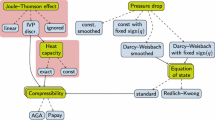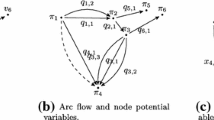Abstract
The paper considers the computation of the probability of feasible load constellations in a stationary gas network with uncertain demand. More precisely, a network with a single entry and several exits with uncertain loads is studied. Feasibility of a load constellation is understood in the sense of an existing flow meeting these loads along with given pressure bounds in the pipes. In a first step, feasibility of deterministic exit loads is characterized algebraically and these general conditions are specified to networks involving at most one cycle. This prerequisite is essential for determining probabilities in a stochastic setting when exit loads are assumed to follow some (joint) Gaussian distribution when modeling uncertain customer demand. The key of our approach is the application of the spheric-radial decomposition of Gaussian random vectors coupled with Quasi Monte-Carlo sampling. This approach requires an efficient algorithmic treatment of the mentioned algebraic relations moreover depending on a scalar parameter. Numerical results are illustrated for different network examples and demonstrate a clear superiority in terms of precision over simple generic Monte-Carlo sampling. They lead to fairly accurate probability values even for moderate sample size.






Similar content being viewed by others
References
Ahuja RK, Magnanti TL, Orlin JB (1993) Network flows. Prentice Hall, New Jersey
Bertsimas D, Tsitsiklis JN (1997) Introduction to linear optimzation. Athena Scientific, Belmont
Brauchart JS, Saff EB, Sloan IH, Womersley RS (2014) QMC designs: optimal order Quasi Monte Carlo integration schemes on the sphere. Math Comput 83:2821–2851
Deák I (2000) Subroutines for Computing normal probabilities of sets—computer experiences. Ann Oper Res 100:103–122
Dick J, Pillichshammer F (2010) Digital nets and sequences: discrepancy theory and Quasi-Monte Carlo integration. Cambridge University Press, Cambridge
Dvijotham K, Vuffray M, Misra S, Chertkov M (2015) Natural gas flow solutions with guarantees: a monotone operator theory approach. Cornell University Library. arXiv:1506.06075v1
Fügenschuh A, Geissler B, Gollmer R, Hayn C, Henrion R, Hiller B, Humpola J, Koch T, Lehmann T, Martin A, Mirkov R, Römisch W, Rövekamp J, Schewe L, Schmidt M, Schultz R, Schwarz R, Schweiger J, Stangl C, Steinbach M, Willert B (2014) Mathematical optimization for challenging network planning problems in unbundled liberalized gas markets. Energy Syst 5:449–473
Genz A, Bretz F (2009) Computation of multivariatenormal and t probabilities (Lecture notes in statistics), vol 195. Springer, Heidelberg
Kirchhoff G (1847) Über die Auflösung der Gleichungen, auf welche man bei der Untersuchung der linearen Verteilung galvanischer Ströme geführt wird. Ann Phys Chem 12:497–508
Koch T, Hiller B, Pfetsch M, Schewe L (eds) (2015) Evaluating gas network capacities. MOS-SIAM Series on optimization, vol 21
Misra S, Vuffray M, Chertkov M (2015) Maximum throughput problem in dissipative flow networks with application to natural gas systems. Cornell University Library. arXiv:1504.02370v1
Osiadacz A (1987) Simulation and analysis of gas networks. Gulf Publishing Company, Houston
Pfetsch M, Fügenschuh A, Geissler B, Geissler N, Gollmer R, Hiller B, Humpola J, Koch T, Lehmann T, Martin A, Morsi A, Rövekamp J, Schewe L, Schmidt M, Schultz R, Schwarz R, Schweiger J, Stangl C, Steinbach M, Vigerske S, Willert B (2015) Validation of nominations in gas network optimization: models, methods, and solutions. Optim Methods and Softw 30:15–53
Prékopa A (1995) Stochastic programming. Kluwer, Dordrecht
Ríos-Mercado RZ, Boras-Sánchez C (2015) Optimization problems in natural gas transportation systems: a state-of-the-art review. Appl Energy 147:536–555
Ríos-Mercado RZ, Wu S, Boyd EA, Scott LR (2000) Model relaxations for the fuel cost minimization of steady-state gas pipeline networks. Math Comput Model 31:197–220
Shapiro A, Dentcheva D, Ruszczyński A (2009) Lectures on stochastic programming. MPS-SIAM series on optimization, vol 9
Stangl C (2014) Modelle, Strukturen und Algorithmen für stationäre Flüsse in Gasnetzen. Dissertation, Fakultät für Mathematik, Universität Duisburg-Essen
Van Ackooij W, Henrion R (2014) Gradient formulae for nonlinear probabilistic constraints with Gaussian and Gaussian-like distributions. SIAM J Optim 24:1864–1889
Vuffray M, Misra S, Chertkov M (2015) Monotonicity of dissipative flow networks renders robust maximum profit problem tractable:general analysis and application to natural gas flow. Cornell University Library. arXiv:1504.000910v1
Wong P, Larson R (1968) Optimization of natural gas pipeline systems via dynamic programming. IEEE Trans Autom Control 13:475–481
Zucker RD, Biblarz B (2002) Fundamentals of gas dynamics, 2nd edn. Wiley, Hoboken
Acknowledgments
The authors thank the Deutsche Forschungsgemeinschaft for their support within Projects B04, B05 in the Sonderforschungsbereich/Transregio 154 Mathematical Modelling, Simulation and Optimization using the Example of Gas Networks. Moreover, we wish to express our gratitude to Open Grid Europe (OGE) for stimulating discussion and providing network data.
Author information
Authors and Affiliations
Corresponding author
Rights and permissions
About this article
Cite this article
Gotzes, C., Heitsch, H., Henrion, R. et al. On the quantification of nomination feasibility in stationary gas networks with random load. Math Meth Oper Res 84, 427–457 (2016). https://doi.org/10.1007/s00186-016-0564-y
Received:
Published:
Issue Date:
DOI: https://doi.org/10.1007/s00186-016-0564-y
Keywords
- Mathematical models for gas pipelines
- Nomination validation
- Gas network capacity
- Uncertainty quantifcation
- Optimization under stochastic uncertainty
- Spheric-radial decomposition




